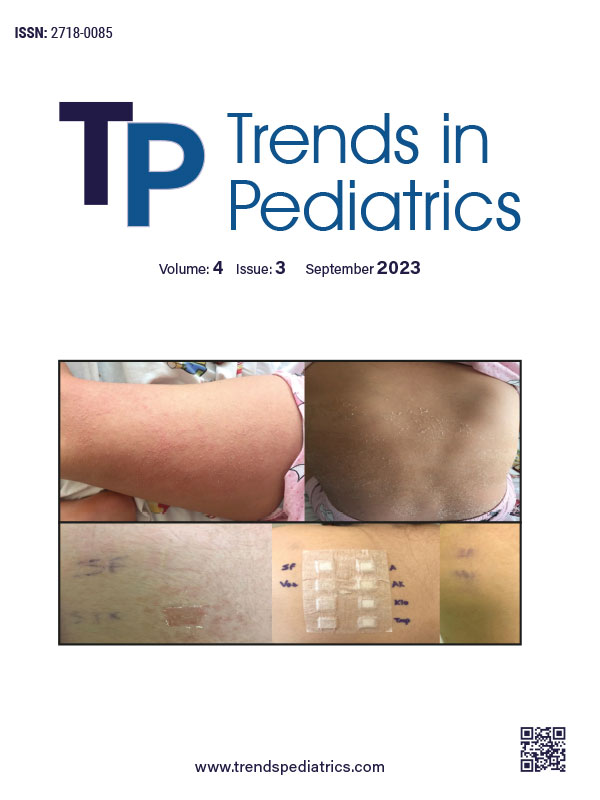Abstract
The incidence of invasive candidiasis (IC) in neonatal intensive care units (NICUs) has significantly increased. Although C. albicans is still the most common pathogen detected in IC cases (60-75%), the increase in the use of prophylactic antifungal therapies and empirical echinocandin has led to a shift in detected pathogens to non-albicans candida species such as C. glabrata (2-8%). In the past, C. glabrata was considered one of the relatively non-pathogenic saprophytes of the normal flora. However, mucosal and systemic C. glabrata infections have escalated with the increase in the survival rates of premature newborns, prolonged hospitalization, and the widespread use of immunosuppressives and broad-spectrum antibiotics and started to appear more frequently as an important nosocomial pathogen, especially with its natural resistance to the azole antifungals. In this article, we aimed to draw attention to the importance of C. glabrata in NICUs by presenting extremely low-birth-weight premature twins with severe clinical course.
Keywords: Extremely low birth weight, invasive candidiasis, Candida glabrata, sepsis
References
- Weimer KED, Smith PB, Puia-Dumitrescu M, Aleem S. Invasive fungal infections in neonates: a review. Pediatr Res. 2022;91:404-12. https://doi.org/10.1038/s41390-021-01842-7
- Fridkin SK, Kaufman D, Edwards JR, Shetty S, Horan T. Changing incidence of Candida bloodstream infections among NICU patients in the United States: 1995-2004. Pediatrics. 2006;117:1680-7. https://doi.org/10.1542/peds.2005-1996
- Lausch KR, Schultz Dungu KH, Callesen MT, et al. Pediatric candidemia epidemiology and morbidities: a nationwide cohort. Pediatr Infect Dis J. 2019;38:464-9. https://doi.org/10.1097/INF.0000000000002207
- Warris A, Pana ZD, Oletto A, et al. Etiology and outcome of candidemia in neonates and children in europe: an 11-year multinational retrospective study. Pediatr Infect Dis J. 2020;39:114-20. https://doi.org/10.1097/INF.0000000000002530
- Pana ZD, Roilides E, Warris A, Groll AH, Zaoutis T. Epidemiology of invasive fungal disease in children. J Pediatric Infect Dis Soc. 2017;6(Suppl 1):S3-11. https://doi.org/10.1093/jpids/pix046
- Steinbach WJ, Roilides E, Berman D, et al. Results from a prospective, international, epidemiologic study of invasive candidiasis in children and neonates. Pediatr Infect Dis J. 2012;31:1252-7. https://doi.org/10.1097/INF.0b013e3182737427
- Fu J, Ding Y, Jiang Y, Mo S, Xu S, Qin P. Persistent candidemia in very low birth weight neonates: risk factors and clinical significance. BMC Infect Dis. 2018;18:558. https://doi.org/10.1186/s12879-018-3487-9
- Kothalawala M, Jayaweera JAAS, Arunan S, Jayathilake A. The emergence of non-albicans candidemia and evaluation of HiChrome Candida differential agar and VITEK2 YST® platform for differentiation of Candida bloodstream isolates in teaching hospital Kandy, Sri Lanka. BMC Microbiol. 2019;19:136. https://doi.org/10.1186/s12866-019-1518-3
- Mohsin J, Weerakoon S, Ahmed S, et al. A Cluster of candida auris blood stream infections in a tertiary care hospital in Oman from 2016 to 2019. Antibiotics (Basel). 2020;9:638. https://doi.org/10.3390/antibiotics9100638
- Chen IT, Chen CC, Huang HC, Kuo KC. Malassezia furfur emergence and candidemia trends in a neonatal intensive care unit during 10 years: the experience of fluconazole prophylaxis in a single hospital. Adv Neonatal Care. 2020;20:E3-8. https://doi.org/10.1097/ANC.0000000000000640
- Chen YN, Hsu JF, Chu SM, et al. Clinical and microbiological characteristics of neonates with candidemia and impacts of therapeutic strategies on the outcomes. J Fungi (Basel). 2022;8:465. https://doi.org/10.3390/jof8050465
- Waggoner-Fountain LA, Walker MW, Hollis RJ, et al. Vertical and horizontal transmission of unique Candida species to premature newborns. Clin Infect Dis. 1996;22:803-8. https://doi.org/10.1093/clinids/22.5.803
- Odds FC, Hanson MF, Davidson AD, et al. One year prospective survey of Candida bloodstream infections in Scotland. J Med Microbiol. 2007;56:1066-75. https://doi.org/10.1099/jmm.0.47239-0
- Malani A, Hmoud J, Chiu L, Carver PL, Bielaczyc A, Kauffman CA. Candida glabrata fungemia: experience in a tertiary care center. Clin Infect Dis. 2005;41:975-81. https://doi.org/10.1086/432939
- Lamba M, Sharma D, Sharma R, Vyas A, Mamoria V. To study the profile of Candida isolates and antifungal susceptibility pattern of neonatal sepsis in a tertiary care hospital of North India. J Matern Fetal Neonatal Med. 2021;34:2655-9. https://doi.org/10.1080/14767058.2019.1670799
- Pappas PG, Kauffman CA, Andes D, et al. Clinical practice guidelines for the management of candidiasis: 2009 update by the Infectious Diseases Society of America. Clin Infect Dis. 2009;48:503-35. https://doi.org/10.1086/596757
- Pfaller MA, Castanheira M, Lockhart SR, Ahlquist AM, Messer SA, Jones RN. Frequency of decreased susceptibility and resistance to echinocandins among fluconazole-resistant bloodstream isolates of Candida glabrata. J Clin Microbiol. 2012;50:1199-203. https://doi.org/10.1128/JCM.06112-11
- Celik IH, Demirel G, Oguz SS, Uras N, Erdeve O, Dilmen U. Compassionate use of voriconazole in newborn infants diagnosed with severe invasive fungal sepsis. Eur Rev Med Pharmacol Sci. 2013;17:729-34.
- Satar M, Arısoy AE, Çelik İH. Türk Neonatoloji Derneği Yenidoğan Enfeksiyonları Tanı ve Tedavi Rehberi 2018. Available at: https://www.neonatology.org.tr/wp-content/uploads/2020/04/yenidogan-enfeksiyonlari-tani-ve-tedavi_rehberi-2018.pdf (Accessed on April 5, 2023).
Copyright and license
Copyright © 2023 The author(s). This is an open-access article published by Aydın Pediatric Society under the terms of the Creative Commons Attribution License (CC BY) which permits unrestricted use, distribution, and reproduction in any medium or format, provided the original work is properly cited.














